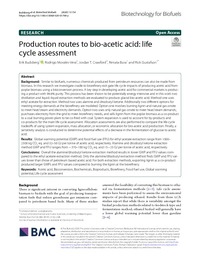Mostrar el registro sencillo de la publicación
Production routes to bio-acetic acid: life cycle assessment
| dc.contributor.author | Budsberg, Erik | |
| dc.contributor.author | Morales-Vera, Rodrigo | |
| dc.contributor.author | Crawford, Jordan T. | |
| dc.contributor.author | Bura, Renata | |
| dc.contributor.author | Gustafson, Rick | |
| dc.date.accessioned | 2020-11-12T19:59:58Z | |
| dc.date.available | 2020-11-12T19:59:58Z | |
| dc.date.issued | 2020 | |
| dc.identifier.uri | http://repositorio.ucm.cl/handle/ucm/3208 | |
| dc.description.abstract | Background: Similar to biofuels, numerous chemicals produced from petroleum resources can also be made from biomass. In this research we investigate cradle to biorefinery exit gate life cycle impacts of producing acetic acid from poplar biomass using a bioconversion process. A key step in developing acetic acid for commercial markets is producing a product with 99.8% purity. This process has been shown to be potentially energy intensive and in this work two distillation and liquid–liquid extraction methods are evaluated to produce glacial bio-acetic acid. Method one uses ethyl acetate for extraction. Method two uses alamine and diisobutyl ketone. Additionally two different options for meeting energy demands at the biorefinery are modeled. Option one involves burning lignin and natural gas onsite to meet heat/steam and electricity demands. Option two uses only natural gas onsite to meet heat/steam demands, purchases electricity from the grid to meet biorefinery needs, and sells lignin from the poplar biomass as a co-product to a coal burning power plant to be co-fired with coal. System expansion is used to account for by-products and co-products for the main life cycle assessment. Allocation assessments are also performed to compare the life cycle tradeoffs of using system expansion, mass allocation, or economic allocation for bio-acetic acid production. Finally, a sensitivity analysis is conducted to determine potential effects of a decrease in the fermentation of glucose to acetic acid. Results: Global warming potential (GWP) and fossil fuel use (FFU) for ethyl acetate extraction range from 1000–2500 kg CO2 eq. and 32–56 GJ per tonne of acetic acid, respectively. Alamine and diisobutyl ketone extraction method GWP and FFU ranges from −370–180 kg CO2 eq. and 15−25 GJ per tonne of acetic acid, respectively. Conclusions: Overall the alamine/diisobutyl ketone extraction method results in lower GWP and FFU values compared to the ethyl acetate extraction method. Only the alamine/diisobutyl extraction method finds GWP and FFU values lower than those of petroleum based acetic acid. For both extraction methods, exporting lignin as a co-product produced larger GWPs and FFU values compared to burning the lignin at the biorefinery. | es_CL |
| dc.language.iso | en | es_CL |
| dc.rights | Atribución-NoComercial-SinDerivadas 3.0 Chile | * |
| dc.rights.uri | http://creativecommons.org/licenses/by-nc-nd/3.0/cl/ | * |
| dc.source | Biotechnology for Biofuels, 13, 154 | es_CL |
| dc.subject | Acetic acid | es_CL |
| dc.subject | Bioconversion | es_CL |
| dc.subject | Biochemicals | es_CL |
| dc.subject | Bioproducts | es_CL |
| dc.subject | Biorefinery | es_CL |
| dc.subject | Fossil fuel use | es_CL |
| dc.subject | Global warming potential | es_CL |
| dc.subject | Life cycle assessment | es_CL |
| dc.title | Production routes to bio-acetic acid: life cycle assessment | es_CL |
| dc.type | Article | es_CL |
| dc.ucm.facultad | Facultad de Ciencias Agrarias y Forestales | es_CL |
| dc.ucm.indexacion | Scopus | es_CL |
| dc.ucm.indexacion | Isi | es_CL |
| dc.ucm.doi | doi.org/10.1186/s13068-020-01784-y | es_CL |



